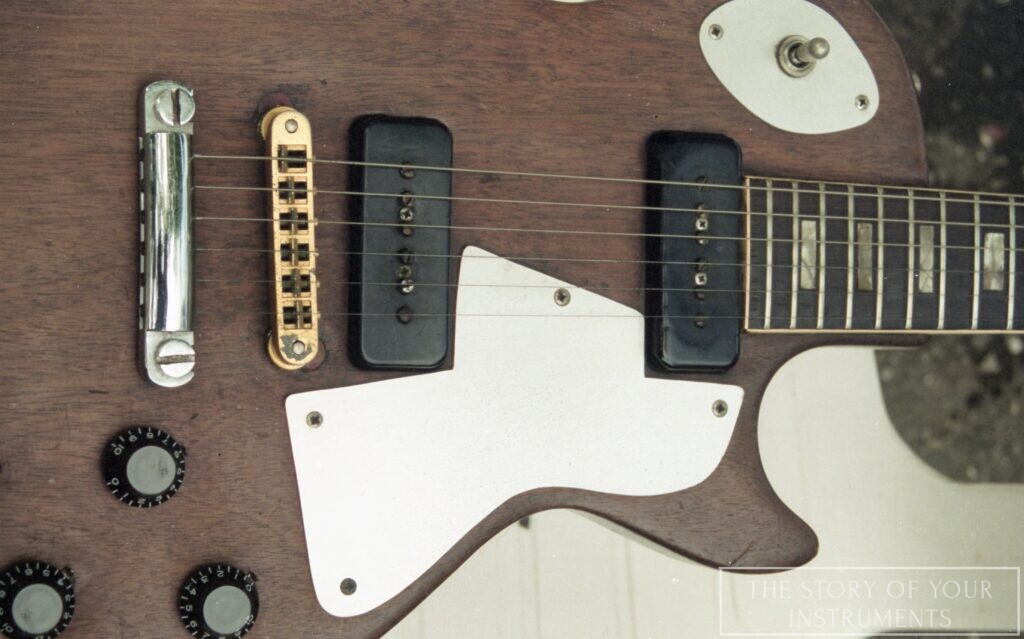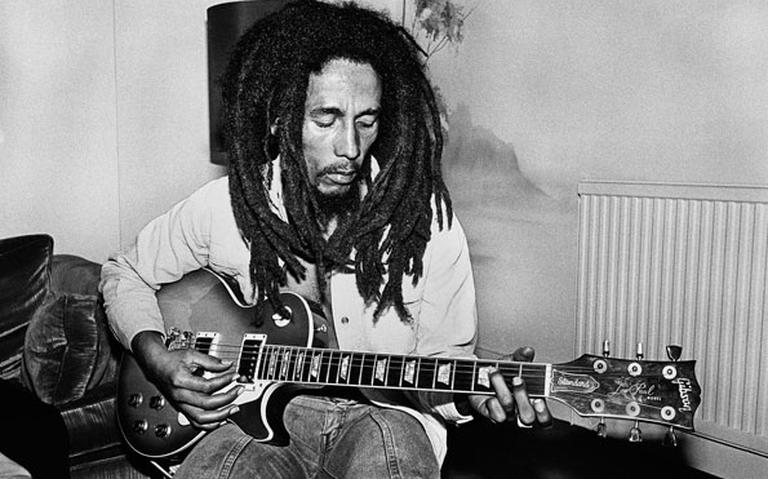
Bob Marley was never a virtuoso guitarist, in fact far from it.
His particular way of approaching the instrument and the technique he adopted have indelibly characterized all his songs.
That guitar strumming caused many other artists after him to follow his style, a style certainly self-taught but with an original method and touch on the keyboard.
With his left hand he never used to do barrè (technique for carrying all tonalities starting with a chord in first position) on minor chords but was supported by his thumb, which he used to play the low strings, unlike playing it for major chords by pressing the keys with only his index and ring fingers.
 Much of the characteristic sound that came out was related to the peculiarity of stopping the strings immediately after playing them, whether with the left or right hand.
Much of the characteristic sound that came out was related to the peculiarity of stopping the strings immediately after playing them, whether with the left or right hand.
And it was precisely with his right hand that Bob gave himself the rhythm and tempo, slowing down and increasing the movement toward the strings, as if continuously accompanying him in his ballets with the instrument.
Marley loved to improvise a lot, both with and without the instrument on his shoulder, although not always but he had a well-defined pattern; he used to open concerts with his guitar in his arms and then end them without it, leaving the stage midway through the final song.
In fact, it is very rare to see Bob playing and singing in some of the songs such as Jamming, Exodus, Could you be Loved, or Get up Stand used almost most of the time as the closing of the concert.
Bob did not own many guitars, he probably did not own more than 5, but we have listed some of those that are known and visible in some photographic and video evidence.
GIBSON LES PAUL SPECIAL

The Gibson Les Paul Special is definitely Bob’s favorite and most used guitar. Purchased in the autumn of 1973 in London, England (above an Edwards replica of the model purchased by Marley in London after the switch was modified).
You can begin to see Marley slinging the Gibson during Burnin’s 1973 British and American tour dates (Capitol Records video October 1973, but we are almost certain that the first date with this model was the concert at Max Kansas’s City in New York in July 1973).
It is also seen in what may be the first video of a Marley, Edmonton London concert scheduled for May but surely moved to November 1973.
MODS

Roger Mayer a friend of Junior Marvin guitarist of the Wailers, in 1979 had the pickguard replaced by the original black one, with one in satin tempered aluminum and again the plate under the tone toggle switch, with one always in aluminum but in the shape of a football ball.
Roger also modified the tuning machines with some Schallers and rewired the entire electric part, leaving the P-90 pickups intact, thus not touching the original sound but making it cleaner, more harmonious, and rustle-free.
Some say the guitar was buried with Bob during the funeral ceremony, but we know for sure that the original guitar was delivered or a Ziggy or Julian Marley and which was exhibited at the Grammy Awards in Los Angeles, and which is occasionally exhibited at Bob Marley Museum Kingston’s.
Gibson reproduced around the early 2000s a replica of Bob‘s guitar, following the specifications of the model from 1979 onward, with a limited number of copies.
Features:
* Aged-cherry finish
* Solid mahogany body
* Mahogany neck
* P-90 single-coil pickups
* Bound fingerboard and overbound headstock
* Aged hardware
* Aluminum pickguard
* Football-shaped switch plate
* Brass nut
* Aluminum tailpiece
* Mini-Schaller tuners
* Rosewood fretboard
* 24-3/4″ scale length
* 1-11/16″ nut width
* Tuner style: Mini-Schaller

FENDER STRATOCASTER
 Marley probably for a short period between 1973 and 1974 he alternated between 2 guitars, Gibson e Fender Sunburst and Bianca (late summer 1973 with the Gibson and in the Lively up yourself 1974 video sessions with the Fender), only to change no more from 1975 onwards.
Marley probably for a short period between 1973 and 1974 he alternated between 2 guitars, Gibson e Fender Sunburst and Bianca (late summer 1973 with the Gibson and in the Lively up yourself 1974 video sessions with the Fender), only to change no more from 1975 onwards.
 It is not known exactly what happened to the guitar today, it seems from rumors that it was stolen during the 1978 Babylon by bus tour but unlikely, there is no more photographic or video evidence of the guitar from 1974 onward.
It is not known exactly what happened to the guitar today, it seems from rumors that it was stolen during the 1978 Babylon by bus tour but unlikely, there is no more photographic or video evidence of the guitar from 1974 onward.
Marley can be seen harnessing the Fender during videos of the Natty Dread 74 (lively up yourself) sessions and at The Old Grey Whistle Test Studios and in several photos from the 1973 Catch a Fire tour dates.
GIBSON SG

 There is absolutely no news about these guitar models owned by Marley, what is known for sure, having seen photographic evidence that Marley brought them with him on stage.
There is absolutely no news about these guitar models owned by Marley, what is known for sure, having seen photographic evidence that Marley brought them with him on stage.
As for the Gibson SG Standard black-colored devil, Bob played this instrument in early 1973 during the British dates of the Catch a Fire tour, almost certainly this guitar was transitional between the Stratocaster and the purchase of the Gibson Les Paul Special.
YAMAHA SG2000

 Of Yamaha it is known that Bob used the guitar during some concerts in Japan in 1979 (Tokyo and Osaka).
Of Yamaha it is known that Bob used the guitar during some concerts in Japan in 1979 (Tokyo and Osaka).
Some models were donated to the band by the then president of Yamaha Corporation.
Marley abandoned the guitar immediately after the ocean dates in Australia and Hawaii, to then give it to Aston Barrett bassist of the Wailers.
GIBSON Les Paul Standard

This photo depicts of Bob in 1978/79 with this guitar model.
Since there is no other live evidence, we believe that the guitar was not his but probably Junior or Al‘s.
OVATION Adamas
 The Ovation is probably the best known acoustic guitar used by Bob. Marley took the instrument with him throughout the 1980 tour, to perform the live version of Redemption Song.
The Ovation is probably the best known acoustic guitar used by Bob. Marley took the instrument with him throughout the 1980 tour, to perform the live version of Redemption Song.
This can also be seen during the recording sessions of the album Uprising, where certainly the recording of the acoustic guitar part of Redemption Song was played with the Ovation.
Not much is known about this guitar, we believe it was purchased by Bob between 1978 and 1979, certainly during an American Tour, it should be the Adamas I 1687-7 Beige model.
EPIPHONE FT 165 12-string
 Bob appears with this model of 12-string guitar (probably not his), in some video and photographic evidence, during the US tour of Uprising in New York in September 1980.
Bob appears with this model of 12-string guitar (probably not his), in some video and photographic evidence, during the US tour of Uprising in New York in September 1980.
In a video where Bob plays versions of Redemption Song and Coming in from the Cold at Essex House (NY), an additional pickup can be seen, installed in the sound hole to amplify the guitar.
1970 GUILD Madeira A-9

Most likely this was one of Bob ‘s guitars , kept at home for songwriting and practice.
The only records depicting Marley with this instrument are David Burnett’s shots at Hope Road in 1976.
Bob pasted a small picture in the guitar case, depicting Haile Selassie and Africa.
HOHNER
 In some 1974 shots at Carlos Place (London) Bob can be seen with an acoustic guitar.
In some 1974 shots at Carlos Place (London) Bob can be seen with an acoustic guitar.
In the photos it is not clear whether it is actually this model, the logo is faded and difficult to understand, but the shapes suggest that it is a Hohner, even if the headstock is not exactly in the style of the manufacturer. (see the guitar is missing a string).
We tried to submit the question directly to Hohner and they confirmed that it could be an older model of theirs, but they can’t be sure.
OVATION Balladeer Acoustic 1112
Bob was photographed in 1977 with Junior Marvin with this guitar model, it is very likely that this guitar was not his either.




Stay connected